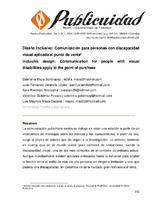Mostrar el registro sencillo del ítem
Diseño inclusivo: Comunicación para personas con discapacidad visual aplicada al punto de venta
| dc.contributor.author | Mejía Bohórquez, Estefanía | |
| dc.contributor.author | Jaramillo López, Juan Fernando | |
| dc.contributor.author | Restrepo Aristizábal, Sara | |
| dc.contributor.author | Gutiérrez Posada, Valentina | |
| dc.contributor.author | Maya Cadavid, Luis Mauricio | |
| dc.coverage.spatial | Seccional Medellín | spa |
| dc.date.accessioned | 2021-01-26T19:29:14Z | |
| dc.date.available | 2021-01-26T19:29:14Z | |
| dc.date.issued | 2014 | |
| dc.identifier.uri | http://hdl.handle.net/20.500.11912/7618 | |
| dc.description | p. 102 - 141 | spa |
| dc.description.abstract | La comunicación publicitaria centra su trabajo en crear una relación a partir de un intercambio de mensajes entre las marcas y los consumidores, a partir de ello, surge el objeto de estudio que da origen a la investigación. Lo anterior, teniendo en cuenta que en el mundo existe gran cantidad de limitaciones, siendo la discapacidad visual, una de las más comunes en el contexto colombiano actual. Aunque mundialmente existen acciones enfocadas hacia la inclusión para acabar la brecha entre el estilo de vida de una persona sin ninguna limitación y una que padece una discapacidad, en Colombia no se le ha dado gran relevancia al tema. Buscando lograr esta inclusión, se llevó a cabo la investigación que da origen a este artículo, con el propósito de dar los primeros pasos hacia una comunicación publicitaria que tenga en cuenta al público discapacitado en el país. La investigación buscaba reconocer las principales dificultades a las que se enfrenta el grupo objeto de estudio, inicialmente desde una perspectiva de expertos en el tema y luego desde las propias experiencias y necesidades del público, para posteriormente, generar recomendaciones para el desarrollo de comunicación publicitaria inclusiva para personas mayores de 40 años en la ciudad de Medellín, que genere una mejor relación entre las marcas y los consumidores en el momento de realizar compras en las grandes superficies. Los resultados del estudio, permiten reconocer la manera como se afecta el estilo de vida y los hábitos de consumo de personas que la padecen y algunas de las acciones erróneas de las comunicaciones publicitarias hechas por las grandes marcas. Así mismo, permite tener una perspectiva, de cómo los cinco sentidos pueden ser involucrados dentro de la comunicación con personas discapacitadas. | spa |
| dc.description.abstract | The advertising focus its efforts in creating a relationship based on an exchange of messages between brands and consumers. Starting from that principle, emerges this investigation. This, keeping in mind that in the world there are a considerable amount of limitations, being visual disabilities, one of the most commons in the current Colombian context. Even though in worldwide level there are actions focused towards inclusion to reduce the gap between the lifestyle of a person without any limitation and one that suffers from a disability, in Colombia there hasn’t been any references about the topic. Looking for that inclusion, this investigation came to life, with the objective of giving the first steps to an advertising communication that takes into consideration the disabled public. The investigation wanted to recognize the main difficulties that faces the objective group of this study, initially from the perspective of experts in the topic and then from the experiences and needs of the target, to finally, create recommendations for the development of inclusive communication and advertising for people above 40 years old in the city of Medellín, that generates a better relationship between brands and costumers at the moment of the purchase in supermarkets. The techniques used for the data collection were interviews and a focus groups with people who suffer of visual disabilities. The results of this study allow the recognizing of the way the lifestyle and consume habits of the people suffering a disability can be affected, and some of the wrong communication actions from big brands. Likewise, it allows to bring a perspective of how the five senses can be involved inside the communications with disabled people. | spa |
| dc.format.mimetype | application/pdf | |
| dc.language.iso | spa | |
| dc.publisher | Universidad Pontificia Bolivariana | spa |
| dc.relation.ispartof | Publicuidad | spa |
| dc.rights | Attribution-NonCommercial-NoDerivatives 4.0 International | * |
| dc.rights.uri | http://creativecommons.org/licenses/by-nc-nd/4.0/ | * |
| dc.subject | Diseño Inclusivo | spa |
| dc.subject | Inclusión | spa |
| dc.subject | Discapacidad Visual | spa |
| dc.subject | Comunicación Publicitaria | spa |
| dc.subject | Punto de Venta | spa |
| dc.subject | Inclusive Design | spa |
| dc.subject | Inclusion | spa |
| dc.subject | Visual Disability | spa |
| dc.subject | Advertising | spa |
| dc.subject | Point Of Purchase | spa |
| dc.title | Diseño inclusivo: Comunicación para personas con discapacidad visual aplicada al punto de venta | spa |
| dc.title.alternative | Inclusive design: Communication for people with visual disabilities apply to the point of purchase | spa |
| dc.type | article | spa |
| dc.rights.accessRights | openAccess | spa |
| dc.type.hasVersion | publishedVersion | spa |
| dc.description.sectional | Medellín | spa |
| dc.identifier.instname | instname:Universidad Pontificia Bolivariana | spa |
| dc.identifier.reponame | reponame:Repositorio Institucional de la Universidad Pontificia Bolivariana | spa |
| dc.identifier.repourl | repourl:https://repository.unab.edu.co/ |


